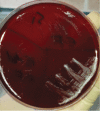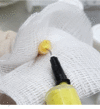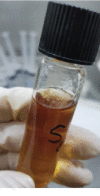Assessment of Nitrofurantoin as an Experimental Intracanal Medicament in Endodontics
- PMID: 32149086
- PMCID: PMC7049449
- DOI: 10.1155/2020/2128473
Assessment of Nitrofurantoin as an Experimental Intracanal Medicament in Endodontics
Abstract
Background and Objectives. Multiple antibacterial agents have been mixed and used as an intracanal medicament-like modified triple antibiotic paste (MTAP) to eliminate Enterococcus faecalis (EF), which has been most frequently identified in the cases of failed root canal treatment and periapical lesions. This study is aimed at using a single antibacterial agent, nitrofurantoin (Nit), as an experimental intracanal medicament paste against different clinical isolates of EF), which has been most frequently identified in the cases of failed root canal treatment and periapical lesions. This study is aimed at using a single antibacterial agent, nitrofurantoin (Nit), as an experimental intracanal medicament paste against different clinical isolates of Materials and Methods. Three strains of EF), which has been most frequently identified in the cases of failed root canal treatment and periapical lesions. This study is aimed at using a single antibacterial agent, nitrofurantoin (Nit), as an experimental intracanal medicament paste against different clinical isolates of n = 90), group M (MTAP) (n = 90), group M (MTAP) (n = 90), group M (MTAP) (EF), which has been most frequently identified in the cases of failed root canal treatment and periapical lesions. This study is aimed at using a single antibacterial agent, nitrofurantoin (Nit), as an experimental intracanal medicament paste against different clinical isolates of n = 90), group M (MTAP) (n = 90), group M (MTAP) (n = 90), group M (MTAP) (EF), which has been most frequently identified in the cases of failed root canal treatment and periapical lesions. This study is aimed at using a single antibacterial agent, nitrofurantoin (Nit), as an experimental intracanal medicament paste against different clinical isolates of.
Results: Nit could eradicate S1, S2, and S3 completely with concentrations of 6.25, 12.5, and 25 mg/mL, respectively, while MTAP showed complete eradication of the three strains only at 25 mg/mL. In all the groups, it was found that the CFU counts of EF), which has been most frequently identified in the cases of failed root canal treatment and periapical lesions. This study is aimed at using a single antibacterial agent, nitrofurantoin (Nit), as an experimental intracanal medicament paste against different clinical isolates of.
Conclusion: At the concentration of 25 mg/mL, the Nit paste is effective in eradicating EF completely when it is used as an intracanal medicament.EF), which has been most frequently identified in the cases of failed root canal treatment and periapical lesions. This study is aimed at using a single antibacterial agent, nitrofurantoin (Nit), as an experimental intracanal medicament paste against different clinical isolates of.
Copyright © 2020 Mewan Salahalddin A. Alrahman et al.
Conflict of interest statement
The authors declare that they have no conflicts of interest.
Figures





Similar articles
-
Antibacterial efficacy of nitrofurantoin impregnated with silver nanoparticles as an intracanal medicament.J Conserv Dent Endod. 2025 Jan;28(1):10-15. doi: 10.4103/JCDE.JCDE_770_24. Epub 2025 Jan 13. J Conserv Dent Endod. 2025. PMID: 39974672 Free PMC article.
-
The effect of intracanal medicaments used in Endodontics on the dislocation resistance of two calcium silicate-based filling materials.BMC Oral Health. 2020 Feb 18;20(1):57. doi: 10.1186/s12903-020-1044-6. BMC Oral Health. 2020. PMID: 32070302 Free PMC article. Clinical Trial.
-
Efficacy of Triple Antibiotic Paste and Bromelain Paste As Intracanal Medicament Against Enterococcus faecalis: An In-Vivo Study.Cureus. 2023 Nov 1;15(11):e48098. doi: 10.7759/cureus.48098. eCollection 2023 Nov. Cureus. 2023. PMID: 38046769 Free PMC article.
-
The use of calcium hydroxide, antibiotics and biocides as antimicrobial medicaments in endodontics.Aust Dent J. 2007 Mar;52(1 Suppl):S64-82. doi: 10.1111/j.1834-7819.2007.tb00527.x. Aust Dent J. 2007. PMID: 17546863 Review.
-
Root canal medicaments.Int Dent J. 2009 Feb;59(1):5-11. Int Dent J. 2009. PMID: 19323305 Review.
Cited by
-
The effectiveness of single antibiotic paste nitrofurantoin V/S double antibiotic paste in alleviation of post-operative pain of patients suffering from symptomatic irreversible pulpitis-A randomized controlled trial.SAGE Open Med. 2023 Dec 29;12:20503121231220794. doi: 10.1177/20503121231220794. eCollection 2024. SAGE Open Med. 2023. PMID: 38162909 Free PMC article.
-
Microbiological Profile of Primary Teeth with Irreversible Pulpitis and Pulp Necrosis with/without Abscess and their Susceptibility to Three Antibiotics as Intracanal Medication.Int J Clin Pediatr Dent. 2023 Mar-Apr;16(2):312-320. doi: 10.5005/jp-journals-10005-2521. Int J Clin Pediatr Dent. 2023. PMID: 37519959 Free PMC article.
-
Direct and residual antimicrobial effect of 2% chlorhexidine gel, double antibiotic paste and chitosan- chlorhexidine nanoparticles as intracanal medicaments against Enterococcus faecalis and Candida albicans in primary molars: an in-vitro study.BMC Oral Health. 2023 Aug 4;23(1):296. doi: 10.1186/s12903-023-02862-x. BMC Oral Health. 2023. PMID: 37542254 Free PMC article.
-
Antibacterial efficacy of nitrofurantoin impregnated with silver nanoparticles as an intracanal medicament.J Conserv Dent Endod. 2025 Jan;28(1):10-15. doi: 10.4103/JCDE.JCDE_770_24. Epub 2025 Jan 13. J Conserv Dent Endod. 2025. PMID: 39974672 Free PMC article.
-
Comparative evaluation of the effect of nitrofurantoin and triple antibiotic paste on the push-out bond strength of epoxy resin sealer: An in vitro study.J Conserv Dent Endod. 2025 Feb;28(2):187-192. doi: 10.4103/JCDE.JCDE_795_24. Epub 2025 Feb 3. J Conserv Dent Endod. 2025. PMID: 40046465 Free PMC article.
References
-
- Nair P. N. R., Sjögren U., Figdor D., Sundqvist G. Persistent periapical radiolucencies of root-filled human teeth, failed endodontic treatments, and periapical scars. Oral Surgery, Oral Medicine, Oral Pathology, Oral Radiology, and Endodontology. 1999;87(5):617–627. doi: 10.1016/S1079-2104(99)70145-9. - DOI - PubMed
MeSH terms
Substances
LinkOut - more resources
Full Text Sources
Medical

